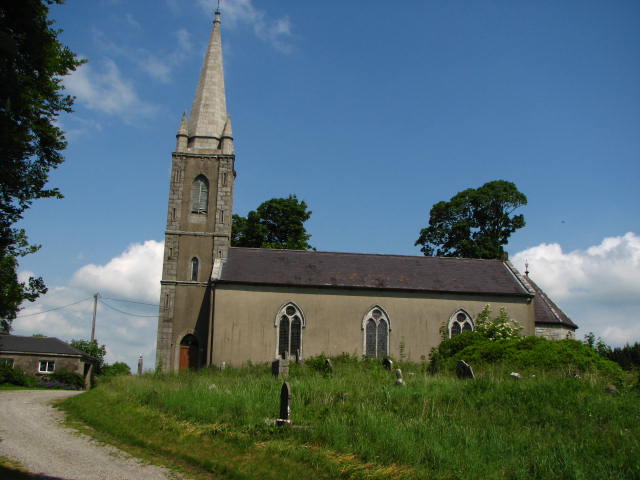Aghade on:
[Wikipedia]
[Google]
[Amazon]
 Aghade () is a small
Aghade () is a small
 All Saints Church of Ireland Church in Aghade is a three-bay church which was built in the late 18th century and renovated in the early 19th century.
Aghade Bridge is a five-arch granite bridge which as built circa 1760 and renovated after 1825. The bridge is used by locals for fishing, kayaking, swimming and sightseeing.
All Saints Church of Ireland Church in Aghade is a three-bay church which was built in the late 18th century and renovated in the early 19th century.
Aghade Bridge is a five-arch granite bridge which as built circa 1760 and renovated after 1825. The bridge is used by locals for fishing, kayaking, swimming and sightseeing.
 Aghade () is a small
Aghade () is a small civil parish
In England, a civil parish is a type of administrative parish used for local government. It is a territorial designation which is the lowest tier of local government below districts and counties, or their combined form, the unitary authorit ...
, in the barony Barony may refer to:
* Barony, the peerage, office of, or territory held by a baron
* Barony, the title and land held in fealty by a feudal baron
* Barony (county division), a type of administrative or geographical division in parts of the British ...
of Forth, County Carlow, Ireland
Ireland ( ; ga, Éire ; Ulster Scots dialect, Ulster-Scots: ) is an island in the Atlantic Ocean, North Atlantic Ocean, in Northwestern Europe, north-western Europe. It is separated from Great Britain to its east by the North Channel (Grea ...
. It is 3 miles from Tullow
Tullow (; , formerly ''Tulach Ó bhFéidhlim/ Tullowphelim'') is a market town in County Carlow, Ireland. It is located on the River Slaney where the N81 road intersects with the R725. , the population was 4,673.
History
There is a statue of ...
and has a notable bridge over the River Slaney
The River Slaney () is a large river in the southeast of Ireland. It rises on Lugnaquilla Mountain in the western Wicklow Mountains and flows west and then south through counties Wicklow, Carlow and Wexford for 117.5 km (73 mi), be ...
. It also has a church, and at one time had a school.
History and mythology
Name
Aghade (or ''Áth Fhád'' in Irish, meaning "long ford") was historically, as the name indicates, a "ford" or crossing place of the river Slaney. In early times an important road or "pass" from Dublin to Wexford ran through Baltinglasss, Tullow and Enniscorthy.Book of Ballymote
In "The Book of Ballymote" it is told how Eochaidh, the son of Enna Cennsealach, killed the poet of Niall of the Nine Hostages. Niall, the High-King, pursued Eochaidh into Leinster, laid waste the province and forced the Leinstermen to surrender Eochaidh to him. He then carried off his prisoners to ''Ath Fadhat'' on the banks of the Slaney and there he left him with a chain around his neck secured to a stone. As Niall retreated northward, nine of his champions returned to put an end to Eochaidh. When the latter saw them coming the ‘legend’ has it that he put forth all his strength, gave a sudden jerk by which he broke the chain and, seizing an iron bar to which it was secured, attacked and slew his champions. Encouraged by this feat the Leinstermen rallied, attacked Niall's army, defeated it and pursued it as far as Tullow slaughtering the retreating troops all the way. In modern times, human bones and skeletons as well as mangled pieces of swords and other military equipment have been dug up from Aghade to Tullow.Christian origins of Aghade and All Saints
In the fifth century Saint Iserninus, Saint Patrick's nephew, resided in and was buried at Aghade. It is argued that Iserninus in close consultation with St. Patrick founded the church here. ‘The Carlow O.S. Letters’ states an abbey for nuns of the Order of St. Augustine was founded by Dermot McMorogh, King of Leinster, in 1151. He appointed it to be a sub abbey of the nunnery of St. Mary de Hoggis in Dublin. It appears that in the reign of Henry VI (1422 – 1461) 60 acres of land in Ardristian as well as the rectory of Aghade belonged to this Abbey or rather to the head house of that order in Dublin city. The present day church occupies the same site of the former convent.Architectural history
 All Saints Church of Ireland Church in Aghade is a three-bay church which was built in the late 18th century and renovated in the early 19th century.
Aghade Bridge is a five-arch granite bridge which as built circa 1760 and renovated after 1825. The bridge is used by locals for fishing, kayaking, swimming and sightseeing.
All Saints Church of Ireland Church in Aghade is a three-bay church which was built in the late 18th century and renovated in the early 19th century.
Aghade Bridge is a five-arch granite bridge which as built circa 1760 and renovated after 1825. The bridge is used by locals for fishing, kayaking, swimming and sightseeing.
References
{{County Carlow Towns and villages in County Carlow